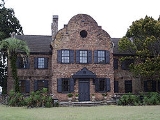
Middleton Place
Encyclopedia
Middleton Place is a plantation
in Dorchester County, directly across the Ashley River from North Charleston
and about 15 miles (24.1 km) northwest of Charleston
, in the U.S. state of South Carolina
. Built in several phases throughout the 18th and 19th centuries, the plantation was the primary residence of several generations of the Middleton family, many of whom played prominent roles in the colonial and antebellum history of South Carolina. The plantation, now a National Historic Landmark District, currently functions as a museum, and is home to the oldest landscaped gardens in the United States.
John Williams, an early South Carolina planter, probably began building Middleton Place in the late 1730s. His son-in-law Henry Middleton
(1717–1784), who later served as President of the First Continental Congress
, completed the house's main section and its north and south flankers, and began work on the elaborate gardens. Middleton's son, Arthur Middleton
(1742–1787), a signer of Declaration of Independence
, was born at Middleton Place, and resided at the plantation in the last years of his life. Arthur Middleton's son and grandson, Henry Middleton
(1770–1846) and Williams Middleton (1809–1883), oversaw Middleton Place's transition from a country residence to a more active rice plantation. In 1865, toward the end of the U.S. Civil War, Union
soldiers burned most of the house, leaving only the south wing and gutted walls of the north wing and main house. An earthquake in 1886 toppled the walls of the main house and north wing.
The restoration of Middleton Place largely began in 1916 with the efforts of Middleton descendant John Julius Pringle Smith (1887–1969) and his wife Heningham, both of whom would spend several decades meticulously rebuilding the plantation's gardens. In the early 1970s, approximately 110 acres (44.5 ha) of the 7000 acres (2,832.8 ha) plantation— including the south flanker, the gardens, and several outbuildings— were placed on the National Register of Historic Places
. During the same period the Middleton descendants transferred ownership of the historic district to the non-profit Middleton Place Foundation, which presently maintains the site.
, directly across the river from the City of North Charleston
. This is at a point where the southward-flowing river bends sharply to the east en route to its mouth at Charleston Harbor about 15 miles (24.1 km) downstream. A small northeastward-flowing creek, which has been dammed to form the plantation's rice mill pond, empties into the Ashley at this eastward bend, and forms the historic district's southern boundary. Ashley River Road (part of South Carolina Highway 61
), which connects Middleton Place to Charleston to the southeast and the Legend Oaks area to the northwest, forms the historic district's western boundary. The plantation's south flanker and residence area sits atop a hill that rises just over 20 feet (6.1 m) above the river, allowing an unobstructed view of the river for nearly a mile downstream.
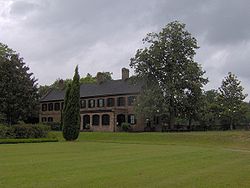 Middleton Place was established in the 1730s by early South Carolina planter John Williams. Williams likely began construction on the main block of the house, selecting the site for its strategic view of the Ashley River. After Williams' death, the plantation became part of the dowry of his daughter, Mary Williams. In 1741, Mary Williams married Henry Middleton, whose name was subsequently applied to the plantation. Middleton's father had immigrated from Barbados
Middleton Place was established in the 1730s by early South Carolina planter John Williams. Williams likely began construction on the main block of the house, selecting the site for its strategic view of the Ashley River. After Williams' death, the plantation became part of the dowry of his daughter, Mary Williams. In 1741, Mary Williams married Henry Middleton, whose name was subsequently applied to the plantation. Middleton's father had immigrated from Barbados
and had established a plantation in the area which is now part of the cities of Goose Creek
- North Charleston
. Henry's older brother, William, built the Crowfield plantation in the 1730s, but eventually moved to England, leaving Henry in charge of the family's affairs in South Carolina. Henry continued acquiring land, eventually becoming one of South Carolina's wealthiest planters. At one point, he owned 20 plantations consisting of 50000 acres (20,234.3 ha) and 800 slaves.
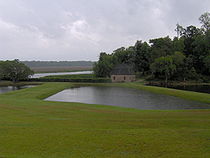 Henry likely planned Middleton Place as a country residence moreso than an active rice plantation. The original main house, completed around 1741, was three stories tall, built of brick in Jacobean-style. In 1755, Middleton added two two-story free-standing wings, or "flankers," to the north and south ends of the house. The free-standing north wing contained a library and ballroom, while the south wing was used as a guest house.
Henry likely planned Middleton Place as a country residence moreso than an active rice plantation. The original main house, completed around 1741, was three stories tall, built of brick in Jacobean-style. In 1755, Middleton added two two-story free-standing wings, or "flankers," to the north and south ends of the house. The free-standing north wing contained a library and ballroom, while the south wing was used as a guest house.
Middleton began work on the plantation's gardens in 1741. Determined to outshine his neighbors, who were laying out neat four-squared patterned parterres, Middleton employed an English gardener named Simms, of whom little is known. Basing his designs less upon his own trip to England, Middleton and Simms derived their inspiration from the engraved plans in the translation of the popular garden book by Dezallier d'Argenville
, The Theory and Practice of Gardening. Middleton and Simms extended a main axis centered on the main block of the house, expressed as a gravel carriageway leading through a greensward to the first of six shaped turf terraces with bowed centers. At the level of the river a pair of lakes (the "Butterfly Lakes") were excavated on either side of a turf causeway prolonging the axis. With the river beyond, the lakes were flanked by more water, a stream dammed to the right to form the long narrow Rice Mill Pond, and a levee
extended to the left to enclose floodable rice fields.
After Mary Middleton's death in 1761, Henry moved to a small house north of Charleston and gave Middleton Place to his son, Arthur. In 1776, at the outbreak of the American Revolution
, Arthur signed the Declaration of Independence. Four years later, at the height of the war, the British landed several thousand troops at Charleston with plans to invade the southern colonies. In the ensuing Siege of Charleston
, British troops ransacked Middleton Place, beheading many of the statues and looting the plantation's artwork and furniture. Arthur Middleton was captured and imprisoned until 1781. In 1783, the surrender terms eliminating British troops from the Southern colonies was signed at Middleton.
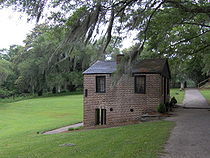 Newly discovered records show that Middleton Place imported water buffalo
Newly discovered records show that Middleton Place imported water buffalo
from Constantinople
in the late 18th century, the first in the United States. They were experimental draft animals, suited to the deep muck in which rice was grown. In the gardens, Arthur's son Henry Middleton's friendship with French botanist André Michaux
resulted in the first camellia
s grown in an American garden, a house gift during Michaux's visit in 1786. Three of the four planted at the corners of the main parterre survive, grown to fifteen feet: One is Camellia japonica
"reine des fleurs"; the other is an ancestor of the modern cultivar Charles Sprague Sargent
. The second Henry Middleton expanded and enriched the gardens, introducing the garden's first Asiatic azalea
(Rhododendron indica), and the crape myrtle ( Lagerstroemia indica
), one of the oldest in America. He also filled greenhouses with exotics and imported plants and seeds to give antebellum Middleton Place something of the air of a botanical garden
.
Upon Henry Middleton's death in 1846, Middleton Place passed to his son, Williams Middleton.
In 1860, Williams Middleton signed the South Carolina Ordinance of Secession
, in which the state declared it was no longer part of the United States. South Carolina's actions led to the attack on Fort Sumter
in April 1861, sparking the U.S. Civil War. In February 1865, near the end of the war, Union troops captured Middleton Place and burned the main house and north flanker, and part of the south flanker. The soldiers also killed and ate five of the water buffalo and stole six. These six later showed up in Central Park Zoo.
In 1868, Williams Middleton restored the roof to the south flanker at Middleton Place, and converted it to the main residence. He lacked the money for major restorations, however, and managed to obtain only limited success as a large-scale planter. After his death in 1883, Middleton Place passed to wife, Susan. Three years later, the Charleston earthquake
toppled the walls of the main house and north flanker and further damaged the gardens. The gardens lay neglected for several decades afterward.
 Williams Middleton's daughter, Elizabeth, inherited Middleton Place in 1900, and made minor restorations. Upon her death in 1915, she left the plantation to her cousin, John Julius Pringle Smith (Smith was a great-great-great-grandson of Henry Middleton). Smith and his wife, Heningham, used Middleton Place as their winter residence. Determined to restore the gardens to their original splendor, the Smiths labored for several years, replanting and reworking the gardens. They opened the plantation's gardens to the public in the late 1920s. In 1941, the Garden Club of America called the Middleton Place gardens "the most interesting and important garden in the United States."
Williams Middleton's daughter, Elizabeth, inherited Middleton Place in 1900, and made minor restorations. Upon her death in 1915, she left the plantation to her cousin, John Julius Pringle Smith (Smith was a great-great-great-grandson of Henry Middleton). Smith and his wife, Heningham, used Middleton Place as their winter residence. Determined to restore the gardens to their original splendor, the Smiths labored for several years, replanting and reworking the gardens. They opened the plantation's gardens to the public in the late 1920s. In 1941, the Garden Club of America called the Middleton Place gardens "the most interesting and important garden in the United States."
In the 1930s, the Smiths began restoring the house and outbuildings at Middleton Place to their late 18th-century appearance. In 1971, the plantation was added to the National Register of Historic Places and designated a National Historic Landmark District. Shortly thereafter the Middleton Place Foundation was established, with Smith's grandson Charles Duell acting as its first president. In recent years, the Middleton Place Foundation has carried out extensive research to document the thousands of African-American slaves once owned by the Middleton family.
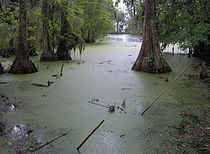 The original access to Middleton Place was a roadway that ran due east from Ashley River Road for approximately 1000 feet (304.8 m) before terminating in a large loop. The main residence (now consisting of only the south flanker) lay at the east end of the loop, the stables (now part of a demonstration area) were at the south end of the loop, and the family burial grounds and main garden area were at the north end. The terraced gardens and butterfly ponds lay east of the main residence. The original roadway, the main gate of the original residence, and the levee separating the two Butterfly Lakes were all situated on a continuous east-west axis.
The original access to Middleton Place was a roadway that ran due east from Ashley River Road for approximately 1000 feet (304.8 m) before terminating in a large loop. The main residence (now consisting of only the south flanker) lay at the east end of the loop, the stables (now part of a demonstration area) were at the south end of the loop, and the family burial grounds and main garden area were at the north end. The terraced gardens and butterfly ponds lay east of the main residence. The original roadway, the main gate of the original residence, and the levee separating the two Butterfly Lakes were all situated on a continuous east-west axis.
The northwest section of Middleton consists of a densely-forested woodland which gives way to a marsh at the riverbank. This natural area is separated from the north gardens by an 800 feet (243.8 m) by 100 feet (30.5 m) rectangular pool (known as the Reflection Pool) on the west side of the gardens and a smaller less-defined pool (known as the Azalea Pool) on the north side. The north gardens are laid out in grid-like fashion with each surrounded by hedges and separated by walkways. On the east side of the gardens is a "spoked wheel" formation roughly 100 feet (30.5 m) in diameter. Perhaps the most notable feature of the gardens is the "Middleton Oak," or "Great Oak," a massive live oak
tree with a trunk more than 10 feet (3 m) in diameter.
The east gardens stretch eastward from the main residence for approximately 200 feet (61 m) before descending in a series of terraces to the floodplain of the Ashley River. Two congruent ponds at the eastern base of the terraces resemble butterfly wings, and are thus known as the "Butterfly Lakes." Levees separate the ponds from the river to the north and from the mill pond to the south. A smaller 150 feet (45.7 m) by 150 feet (45.7 m) garden (subdivided into four still smaller gardens) lies between the north and east gardens.
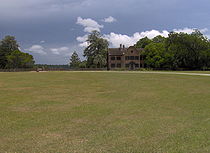 The Middleton Place House, formerly the south wing or south flanker, was built in 1755 by Henry Middleton (one stone of the house contains Middleton's initials and the year "1755"). The roof was added in 1868, after the original roof was destroyed when Union soldiers burned the property. The house is a two-story, 52 feet (15.8 m) by 20 feet (6.1 m) structure with a gabled roof and stepped and curvilinear gable ends. An 18 feet (5.5 m) by 28 feet (8.5 m) service wing was added to the south side of the house in the 1930s (the wing was built in the same 18th-century style as the house). The first floor of the house originally contained a parlor, living room, and dining room, while the second floor contained three bedrooms. The interior has been outfitted with original furniture.
The Middleton Place House, formerly the south wing or south flanker, was built in 1755 by Henry Middleton (one stone of the house contains Middleton's initials and the year "1755"). The roof was added in 1868, after the original roof was destroyed when Union soldiers burned the property. The house is a two-story, 52 feet (15.8 m) by 20 feet (6.1 m) structure with a gabled roof and stepped and curvilinear gable ends. An 18 feet (5.5 m) by 28 feet (8.5 m) service wing was added to the south side of the house in the 1930s (the wing was built in the same 18th-century style as the house). The first floor of the house originally contained a parlor, living room, and dining room, while the second floor contained three bedrooms. The interior has been outfitted with original furniture.
Plantation
A plantation is a long artificially established forest, farm or estate, where crops are grown for sale, often in distant markets rather than for local on-site consumption...
in Dorchester County, directly across the Ashley River from North Charleston
North Charleston, South Carolina
North Charleston is the 3rd largest city in the U.S. state of South Carolina with incorporated areas in Berkeley, Charleston, and Dorchester counties. On June 12, 1972 the city of North Charleston incorporated and was the 9th largest city in South Carolina. According to the 2010 Census, North...
and about 15 miles (24.1 km) northwest of Charleston
Charleston, South Carolina
Charleston is the second largest city in the U.S. state of South Carolina. It was made the county seat of Charleston County in 1901 when Charleston County was founded. The city's original name was Charles Towne in 1670, and it moved to its present location from a location on the west bank of the...
, in the U.S. state of South Carolina
South Carolina
South Carolina is a state in the Deep South of the United States that borders Georgia to the south, North Carolina to the north, and the Atlantic Ocean to the east. Originally part of the Province of Carolina, the Province of South Carolina was one of the 13 colonies that declared independence...
. Built in several phases throughout the 18th and 19th centuries, the plantation was the primary residence of several generations of the Middleton family, many of whom played prominent roles in the colonial and antebellum history of South Carolina. The plantation, now a National Historic Landmark District, currently functions as a museum, and is home to the oldest landscaped gardens in the United States.
John Williams, an early South Carolina planter, probably began building Middleton Place in the late 1730s. His son-in-law Henry Middleton
Henry Middleton
Henry Middleton was a plantation owner and public official from South Carolina. He was the second President of the Continental Congress from October 22, 1774, until Peyton Randolph was able to resume his duties briefly beginning on May 10, 1775.-Early life:Henry Middleton was born in 1717 near...
(1717–1784), who later served as President of the First Continental Congress
First Continental Congress
The First Continental Congress was a convention of delegates from twelve of the thirteen North American colonies that met on September 5, 1774, at Carpenters' Hall in Philadelphia, Pennsylvania, early in the American Revolution. It was called in response to the passage of the Coercive Acts by the...
, completed the house's main section and its north and south flankers, and began work on the elaborate gardens. Middleton's son, Arthur Middleton
Arthur Middleton
Arthur Middleton , of Charleston, South Carolina, was a signer of the United States Declaration of Independence....
(1742–1787), a signer of Declaration of Independence
Declaration of independence
A declaration of independence is an assertion of the independence of an aspiring state or states. Such places are usually declared from part or all of the territory of another nation or failed nation, or are breakaway territories from within the larger state...
, was born at Middleton Place, and resided at the plantation in the last years of his life. Arthur Middleton's son and grandson, Henry Middleton
Henry Middleton (governor)
Henry Middleton was an American planter and political leader from Charleston, South Carolina. He was the 43rd Governor of South Carolina , represented South Carolina in the U. S...
(1770–1846) and Williams Middleton (1809–1883), oversaw Middleton Place's transition from a country residence to a more active rice plantation. In 1865, toward the end of the U.S. Civil War, Union
Union (American Civil War)
During the American Civil War, the Union was a name used to refer to the federal government of the United States, which was supported by the twenty free states and five border slave states. It was opposed by 11 southern slave states that had declared a secession to join together to form the...
soldiers burned most of the house, leaving only the south wing and gutted walls of the north wing and main house. An earthquake in 1886 toppled the walls of the main house and north wing.
The restoration of Middleton Place largely began in 1916 with the efforts of Middleton descendant John Julius Pringle Smith (1887–1969) and his wife Heningham, both of whom would spend several decades meticulously rebuilding the plantation's gardens. In the early 1970s, approximately 110 acres (44.5 ha) of the 7000 acres (2,832.8 ha) plantation— including the south flanker, the gardens, and several outbuildings— were placed on the National Register of Historic Places
National Register of Historic Places
The National Register of Historic Places is the United States government's official list of districts, sites, buildings, structures, and objects deemed worthy of preservation...
. During the same period the Middleton descendants transferred ownership of the historic district to the non-profit Middleton Place Foundation, which presently maintains the site.
Location
Middleton Place is situated along the southwest bank of the Ashley RiverAshley River (South Carolina)
The Ashley River is a blackwater / tidal river in South Carolina, rising from the Wassamassaw and Great Cypress Swamps in western Berkeley County. It consolidates its main channel about five miles west of Summerville, widening into a tidal estuary just south of Fort Dorchester...
, directly across the river from the City of North Charleston
North Charleston, South Carolina
North Charleston is the 3rd largest city in the U.S. state of South Carolina with incorporated areas in Berkeley, Charleston, and Dorchester counties. On June 12, 1972 the city of North Charleston incorporated and was the 9th largest city in South Carolina. According to the 2010 Census, North...
. This is at a point where the southward-flowing river bends sharply to the east en route to its mouth at Charleston Harbor about 15 miles (24.1 km) downstream. A small northeastward-flowing creek, which has been dammed to form the plantation's rice mill pond, empties into the Ashley at this eastward bend, and forms the historic district's southern boundary. Ashley River Road (part of South Carolina Highway 61
South Carolina Highway 61
South Carolina Highway 61 is a long highway in the U.S. state of South Carolina. The highway is designated on an east–west direction, from U.S. Route 78 near Branchville to South Carolina Highway 30 in Charleston. The portion of Highway 61 from Church Creek Bridge and ten miles north is...
), which connects Middleton Place to Charleston to the southeast and the Legend Oaks area to the northwest, forms the historic district's western boundary. The plantation's south flanker and residence area sits atop a hill that rises just over 20 feet (6.1 m) above the river, allowing an unobstructed view of the river for nearly a mile downstream.
Colonial and Revolutionary period

Barbados
Barbados is an island country in the Lesser Antilles. It is in length and as much as in width, amounting to . It is situated in the western area of the North Atlantic and 100 kilometres east of the Windward Islands and the Caribbean Sea; therein, it is about east of the islands of Saint...
and had established a plantation in the area which is now part of the cities of Goose Creek
Goose Creek, South Carolina
Goose Creek is a city in Berkeley county in the U.S. state of South Carolina. The population was 35,938 at the 2010 census. Most of the Naval Weapons Station Charleston is in Goose Creek. As defined by the U.S. Office of Management and Budget, and used by the U.S...
- North Charleston
North Charleston, South Carolina
North Charleston is the 3rd largest city in the U.S. state of South Carolina with incorporated areas in Berkeley, Charleston, and Dorchester counties. On June 12, 1972 the city of North Charleston incorporated and was the 9th largest city in South Carolina. According to the 2010 Census, North...
. Henry's older brother, William, built the Crowfield plantation in the 1730s, but eventually moved to England, leaving Henry in charge of the family's affairs in South Carolina. Henry continued acquiring land, eventually becoming one of South Carolina's wealthiest planters. At one point, he owned 20 plantations consisting of 50000 acres (20,234.3 ha) and 800 slaves.

Middleton began work on the plantation's gardens in 1741. Determined to outshine his neighbors, who were laying out neat four-squared patterned parterres, Middleton employed an English gardener named Simms, of whom little is known. Basing his designs less upon his own trip to England, Middleton and Simms derived their inspiration from the engraved plans in the translation of the popular garden book by Dezallier d'Argenville
Dezallier d'Argenville
The family of Dezallier d'Argenville produced two writers and connoisseurs in the course of the 18th century.Antoine-Joseph Dezallier d'Argenville , avocat to the Parlement de Paris and secretary to the king, was a connoisseur of gardening who laid out two for himself and his family, before writing...
, The Theory and Practice of Gardening. Middleton and Simms extended a main axis centered on the main block of the house, expressed as a gravel carriageway leading through a greensward to the first of six shaped turf terraces with bowed centers. At the level of the river a pair of lakes (the "Butterfly Lakes") were excavated on either side of a turf causeway prolonging the axis. With the river beyond, the lakes were flanked by more water, a stream dammed to the right to form the long narrow Rice Mill Pond, and a levee
Levee
A levee, levée, dike , embankment, floodbank or stopbank is an elongated naturally occurring ridge or artificially constructed fill or wall, which regulates water levels...
extended to the left to enclose floodable rice fields.
After Mary Middleton's death in 1761, Henry moved to a small house north of Charleston and gave Middleton Place to his son, Arthur. In 1776, at the outbreak of the American Revolution
American Revolutionary War
The American Revolutionary War , the American War of Independence, or simply the Revolutionary War, began as a war between the Kingdom of Great Britain and thirteen British colonies in North America, and ended in a global war between several European great powers.The war was the result of the...
, Arthur signed the Declaration of Independence. Four years later, at the height of the war, the British landed several thousand troops at Charleston with plans to invade the southern colonies. In the ensuing Siege of Charleston
Siege of Charleston
The Siege of Charleston was one of the major battles which took place towards the end of the American Revolutionary War, after the British began to shift their strategic focus towards the American Southern Colonies. After about six weeks of siege, Continental Army Major General Benjamin Lincoln...
, British troops ransacked Middleton Place, beheading many of the statues and looting the plantation's artwork and furniture. Arthur Middleton was captured and imprisoned until 1781. In 1783, the surrender terms eliminating British troops from the Southern colonies was signed at Middleton.
Antebellum period

Water buffalo
The water buffalo is a domesticated bovid widely kept in Asia, Europe and South America.Water buffalo can also refer to:*Wild water buffalo , the wild ancestor of the domestic water buffalo...
from Constantinople
Constantinople
Constantinople was the capital of the Roman, Eastern Roman, Byzantine, Latin, and Ottoman Empires. Throughout most of the Middle Ages, Constantinople was Europe's largest and wealthiest city.-Names:...
in the late 18th century, the first in the United States. They were experimental draft animals, suited to the deep muck in which rice was grown. In the gardens, Arthur's son Henry Middleton's friendship with French botanist André Michaux
André Michaux
André Michaux was a French botanist and explorer.-Biography:Michaux was born in Satory, now part of Versailles, Yvelines. After the death of his wife within a year of their marriage he took up the study of botany and was a student of Bernard de Jussieu...
resulted in the first camellia
Camellia
Camellia, the camellias, is a genus of flowering plants in the family Theaceae. They are found in eastern and southern Asia, from the Himalaya east to Korea and Indonesia. There are 100–250 described species, with some controversy over the exact number...
s grown in an American garden, a house gift during Michaux's visit in 1786. Three of the four planted at the corners of the main parterre survive, grown to fifteen feet: One is Camellia japonica
Camellia japonica
The Japanese Camellia is one of the best known species of camellia. Sometimes called the rose of winter, it is a member of the Theaceae family or tea family. It is a flowering shrub or a small tree native to Japan, Korea and China. It is the official state flower of Alabama.-Description:In the...
"reine des fleurs"; the other is an ancestor of the modern cultivar Charles Sprague Sargent
Charles Sprague Sargent
Charles Sprague Sargent was an American botanist. He was the first director of the Arnold Arboretum at Harvard University in Boston, Massachusetts and the standard botanical author abbreviation Sarg. is applied to plants he described.-Biography:Sargent was the second son of Henrietta and...
. The second Henry Middleton expanded and enriched the gardens, introducing the garden's first Asiatic azalea
Azalea
Azaleas are flowering shrubs comprising two of the eight subgenera of the genus Rhododendron, Pentanthera and Tsutsuji . Azaleas bloom in spring, their flowers often lasting several weeks...
(Rhododendron indica), and the crape myrtle ( Lagerstroemia indica
Lagerstroemia indica
Lagerstroemia indica is a species in the genus Lagerstroemia in the family Lythraceae.From China, Korea and Japan, Lagerstroemia indica is an often multistemmed, deciduous tree with a wide spreading, flat topped, open habit when mature.The bark is a prominent feature being smooth, pinkinsh-gray...
), one of the oldest in America. He also filled greenhouses with exotics and imported plants and seeds to give antebellum Middleton Place something of the air of a botanical garden
Botanical garden
A botanical garden The terms botanic and botanical, and garden or gardens are used more-or-less interchangeably, although the word botanic is generally reserved for the earlier, more traditional gardens. is a well-tended area displaying a wide range of plants labelled with their botanical names...
.
Upon Henry Middleton's death in 1846, Middleton Place passed to his son, Williams Middleton.
In 1860, Williams Middleton signed the South Carolina Ordinance of Secession
Ordinance of Secession
The Ordinance of Secession was the document drafted and ratified in 1860 and 1861 by the states officially seceding from the United States of America...
, in which the state declared it was no longer part of the United States. South Carolina's actions led to the attack on Fort Sumter
Battle of Fort Sumter
The Battle of Fort Sumter was the bombardment and surrender of Fort Sumter, near Charleston, South Carolina, that started the American Civil War. Following declarations of secession by seven Southern states, South Carolina demanded that the U.S. Army abandon its facilities in Charleston Harbor. On...
in April 1861, sparking the U.S. Civil War. In February 1865, near the end of the war, Union troops captured Middleton Place and burned the main house and north flanker, and part of the south flanker. The soldiers also killed and ate five of the water buffalo and stole six. These six later showed up in Central Park Zoo.
In 1868, Williams Middleton restored the roof to the south flanker at Middleton Place, and converted it to the main residence. He lacked the money for major restorations, however, and managed to obtain only limited success as a large-scale planter. After his death in 1883, Middleton Place passed to wife, Susan. Three years later, the Charleston earthquake
Charleston earthquake
The Charleston Earthquake of 1886 was a powerful intraplate earthquake that hit the area of Charleston, South Carolina. After the 1811 and 1812 quakes in New Madrid, Missouri, it is one of the most powerful and damaging quakes to hit the southeastern United States. The shaking occurred at 9:50 p.m....
toppled the walls of the main house and north flanker and further damaged the gardens. The gardens lay neglected for several decades afterward.
Restoration

In the 1930s, the Smiths began restoring the house and outbuildings at Middleton Place to their late 18th-century appearance. In 1971, the plantation was added to the National Register of Historic Places and designated a National Historic Landmark District. Shortly thereafter the Middleton Place Foundation was established, with Smith's grandson Charles Duell acting as its first president. In recent years, the Middleton Place Foundation has carried out extensive research to document the thousands of African-American slaves once owned by the Middleton family.
Layout

The northwest section of Middleton consists of a densely-forested woodland which gives way to a marsh at the riverbank. This natural area is separated from the north gardens by an 800 feet (243.8 m) by 100 feet (30.5 m) rectangular pool (known as the Reflection Pool) on the west side of the gardens and a smaller less-defined pool (known as the Azalea Pool) on the north side. The north gardens are laid out in grid-like fashion with each surrounded by hedges and separated by walkways. On the east side of the gardens is a "spoked wheel" formation roughly 100 feet (30.5 m) in diameter. Perhaps the most notable feature of the gardens is the "Middleton Oak," or "Great Oak," a massive live oak
Live oak
Live oak , also known as the southern live oak, is a normally evergreen oak tree native to the southeastern United States...
tree with a trunk more than 10 feet (3 m) in diameter.
The east gardens stretch eastward from the main residence for approximately 200 feet (61 m) before descending in a series of terraces to the floodplain of the Ashley River. Two congruent ponds at the eastern base of the terraces resemble butterfly wings, and are thus known as the "Butterfly Lakes." Levees separate the ponds from the river to the north and from the mill pond to the south. A smaller 150 feet (45.7 m) by 150 feet (45.7 m) garden (subdivided into four still smaller gardens) lies between the north and east gardens.
Middleton Place House (south flanker)

Notable outbuildings
- The Middle Place rice mill— located immediately east of the Butterfly Lakes, where a natural east-flowing stream empties into the Ashley River. Williams Middleton built the mill in 1851 as he began more intensive planting at Middleton Place. The mill has undergone several alterations in modern times.
- The Middleton Place springhouse, located behind the south flanker, was built in the 18th century (springhouses were used for refrigeration). In 1850, the second story of the springhouse was converted into a chapel.
- Eliza's House is a freedmanFreedmanA freedman is a former slave who has been released from slavery, usually by legal means. Historically, slaves became freedmen either by manumission or emancipation ....
's residence built around 1870. The house is named after its last occupant, Eliza Leach (1891–1986).
- The Stableyard is a demonstration area that includes a barnyard and stable, both built in the 1930s.
See also
- Drayton HallDrayton HallDrayton Hall, in the South Carolina "Lowcountry" and about 15 miles northwest of Charleston, South Carolina and directly across the Ashley River from North Charleston, South Carolina, is one of the most handsome examples of Palladian architecture in North America.The house was built for John...
- Magnolia Plantation and GardensMagnolia Plantation and Gardens (Charleston, South Carolina)Magnolia Plantation and Gardens is a historic house with gardens located on the Ashley River at 3550 Ashley River Road, Charleston County, South Carolina, United States. It is one of the oldest plantations in the south, and listed on the National Register of Historic Places. The house and gardens...
- List of botanical gardens in the United States
External links
- Middleton Place — official site

